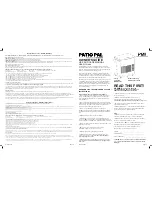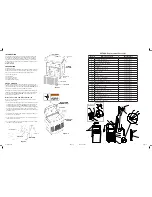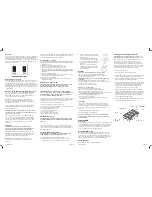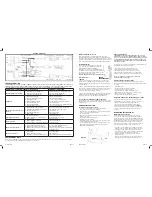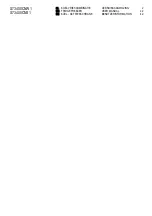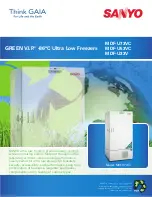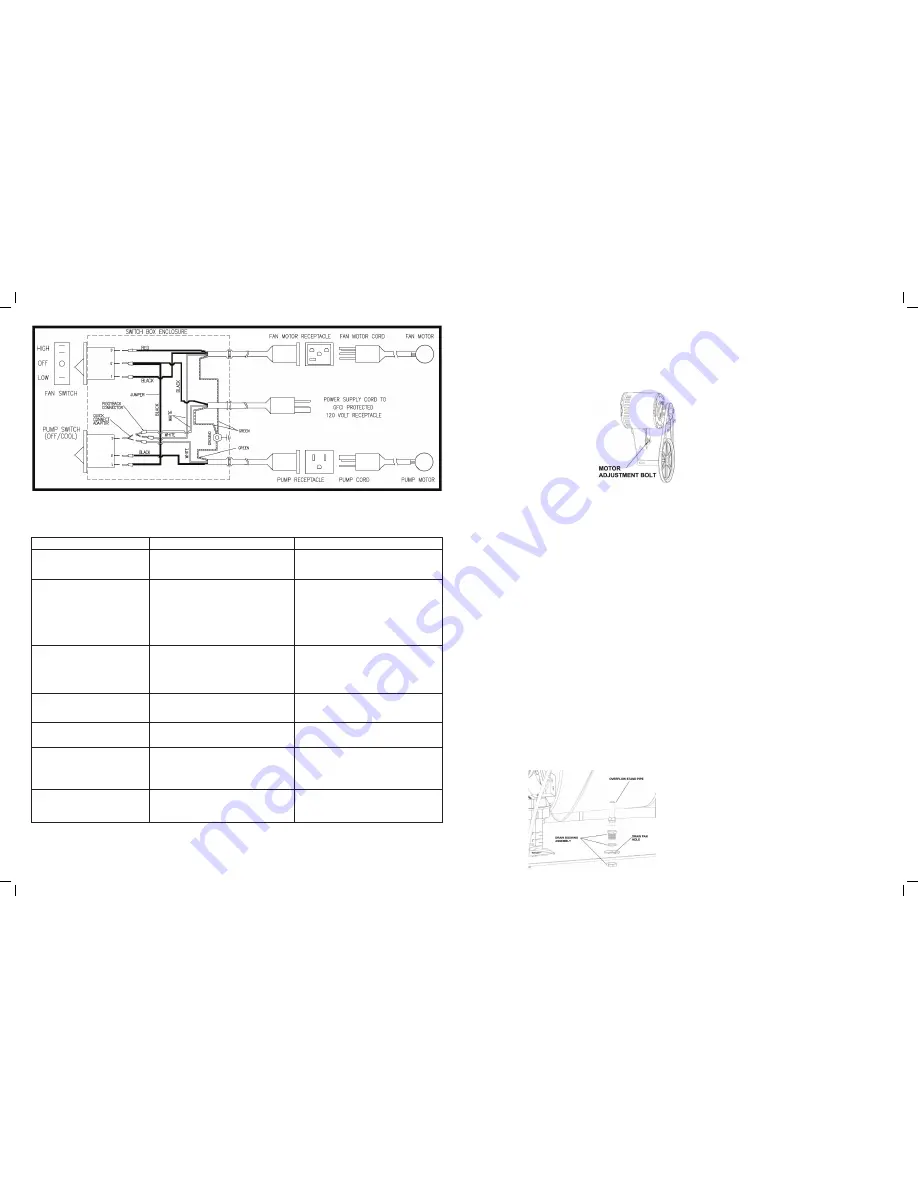
01-999-2521
Page 6
WIRING DIAGRAM
TROUBLESHOOTING:
The following guide is intended to help you diagnose and fix some of the most commonly encountered problems; by no means does
this guide cover all of the possible problems you may encounter. If you cannot diagnose and correct the problem, or if it persists,
contact qualified service personnel. All electrical work should be done by, or with the help of, a qualified electrician.
PROBLEMS / SYMPTOMS POSSIBLE CAUSE
CORRECTIVE ACTION
Water draining from the unit
1. Float valve out of adjustment
2. Float movement obstructed
3. Float valve non-functional
1. Adjust float to 2-2-1/2" water depth.
2. Free float from obstruction
3. Replace float assembly
Dry Media
1. Pump intake clogged
2. Non-functional water pump
3. Clogged water line
4. Water distributor clogged
5. Non-functional switch
6. Non-functional wiring
7. Water turned off to cooler
1. Remove obstruction
2. Replace water pump
3. Locate and free obstruction
4. Clear debris from water distributor
5. Replace switch
6. Repair or replace non-functional wiring
7. Turn on water supply
Motor does not start or no air
delivery
1. Electrical power disconnected
2. Circuit breaker tripped or fuse blown
3. Non-functional motor
4. Non-functional switch
5. Broken belt
1. Check power receptacle and cord
2. Determine cause and correct
3. Replace motor
4. Replace switch
5. Replace belt
Inadequate air delivery
1. Excessive belt tension
2. Blower wheel loose on motor shaft
3. Pads clogged
1. Adjust belt tension
2. Tighten wheel set screw
3. Replace pads
Noisy operation
1. Blower rubbing on housing
2. Motor or blower mounting screws loose
1. Reposition wheel
2. Tighten screws
Musty or unpleasant odor
1. Stale or stagnant water in cooler
2. Media pads clogged or mildewed
3. Media pads not completely wet before
starting fan motor
1. Drain, clean, and flush reservoir
2. Replace media pads
3. Turn pump ON for several minutes prior
to starting cooler
Motor cycles on & off
1. Low voltage
2. Motor shaft tight or frozen
3. Pad frame or air outlet grille removed
1. Check voltage
2. Replace motor
3. Re-install pad frame or air outlet grille
REPLACEMENT PARTS
When ordering replacement parts, always refer to the serial number and model number of your cooler. Use the part numbers listed in the
accompanying parts list, as illustrated in the diagrams for your model.
Motor and Blower check
Remove the pad frame by slightly lifting it from the bottom,
pull outwards until clear of cabinet bottom pan, then downwards
until frame clears cabinet top. Check motor mounting to be sure all
screws and nuts are tightened down properly. Rotate the blower by
hand to see that it moves freely without rubbing against housing.
Belt Adjustment
Correct belt tension and alignment is important
as it cuts power consumption and prolongs life
of the belt and motor. When installing or
adjusting belt, loosen the motor adjustment bolt
and adjust for proper tension. Align belt vertically
by centering motor pulley in-line with blower pulley.
Do
not
adjust motor sheave turns.
Warning: Adjusting sheave turns will void warranty.
Electric Power
CAUTION:
• This cooler is designed for connection to 120 volt AC, 60 Hz
(cycle) power only.
NOTE:
Improper voltage will void the pump
and/or motor warranties and may cause serious personal injury or
property damage.
• This cooler must be plugged into a GFCI protected receptacle,
which has been properly installed in accordance with all local and
national codes. If you are not sure that the receptacle is GFCI
protected, consult with a qualified electrician.
• This cooler is equipped with a power cord having an equipment
grounding conductor and grounding plug.
DO NOT
attempt to
defeat this safety device by removing the grounding pin.
Cooler checkout and first time start-up
Congratulations your cooler is complete and ready for use. Please
proceed to Pre-startup inspection checklist on before starting unit
for the first time.
GENERAL INSPECTION
Pre-Start-up Inspection Checklist
• Cooler is on a level surface, casters locked to prevent
unnecessary movement (prevent spillage).
• Power supply cord is plugged into a GFCI protected receptacle;
cord is secure from accidental damage.
• Float valve installed.
• Water hose connected securely without leaks. Water faucet or
supply is turned on.
• Float adjusted for proper water level.
• Pad frame correctly installed.
• Pump impeller turns freely. Remove impeller cover (see page 5
“Cleaning Pump”) and check rotation.
• Fan, shaft, pulley and motor sheave set bolts/screws are snug.
• Motor sheave alignment okay; belt tension okay (see Belt
Adjustment for instructions).
01-999-2521
Page 3
Start-up Checklist
CAUTION: Never operate unit with pad frame removed. This
will result in an overloaded condition and may damage the fan
motor. The motor and pump have an internal automatic thermal
overload switch that will shut the motor and/or the pump off if
it overheats! The motor and/or pump can restart automatically
when they cool down.
To verify and check out the cooler installation on initial startup, the
following procedure should be followed.
• Push “COOL” switch to ON position (pump on).
• Verify that pump starts and pads are evenly wet.
• Push “FAN” switch to LOW position (low speed on).
• Observe that motor starts and runs. Check high-speed
function by turning “FAN” switch to HIGH (high speed on).
In case of trouble in any of these stages, refer to the
Troubleshooting chart on page 6.
Cabinet Inspection Checklist
After initial start-up and during periodic inspections, check for
and/or observe the following: Refer to the Troubleshooting Chart if
necessary.
• Leaks from cabinet
• Observe cooler media for uneven wetting
• Confirm water level setting is correct.
• Verify full, even flow in water distribution system.
• Blower wheel / motor rotates freely, no unusual noises.
• Belt condition / tension / alignment.
• Check motor mounting and cabinet hardware.
Extended Shut-down (winterizing) checklist
Any time the unit will not be used for an extended period:
• Unplug the cooler power supply cord and secure it out of
the way on the rear of the unit to avoid damage.
• Move cooler to the area appropriate to dump water.
• Remove drain bushing assembly as shown in
Figure 4
• Drain all of the water out of the cooler when not used for
prolonged periods, particularly at the end of the season
(winter).
OPERATING INSTRUCTIONS
Guidelines and location
Always make sure that the roll-around unit is operated
on a solid, level surface strong enough to hold its weight
(Unit can weigh up to 560 lbs. when full). Make sure the two
locking casters have been locked to prevent the cooler from
accidentally moving while in use. Use caution when rolling
the unit to avoid splashing or spilling of water. Unless the
move is for a short distance, it is best to drain the unit, move
it and then refill it in its new location. For best results:
• Turn pump on a few minutes before starting the fan, this
allows the pads to pre-wet and avoids a blast of warm air.
• Turn pump off a few minutes before turning the fan off.
This will allow the pads to dry out, helping to prevent stale
or musty odors the next time the unit is started.
• Whenever possible, operate the fan on low speed for
maximum cooling.
• When cooling is not required, you can operate this unit by
turning on the fan only (leaving the pump turned off).
Figure 4

